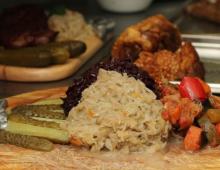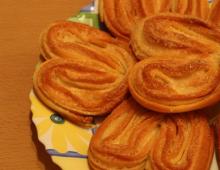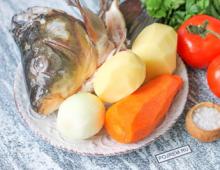How to make jam from whole small apples. A real sweet delicacy: transparent jam from paradise apples with tails. Jam from ranetki with tails - recipe
Good day or night, my reader!
Hooray! I made jam from small apples, just like my grandmother once made during her life! The variety of apple tree from which I prepared this miracle is called “Ural bulk”.
As a child, I loved to enjoy translucent apples in syrup. My grandmother made them perfectly. And this taste of childhood is simply unforgettable!
But due to the fact that I was a child in those days, I naturally did not need a recipe for making this. The main thing is that everything was very tasty. Real heavenly apples!
As an adult, I haven’t tried any number of ways to make this jam. The apples fell apart and that’s it, it turned out to be porridge - malasha. As a result, I threw all my attempts at preparing this deliciousness and beauty into the far corner. I must say that I rarely make jam at all. Instead, I intensively use freezing of vegetables and fruits. But you can’t freeze apples, so we store winter varieties, right up until the end of March, in a pit. Fortunately, this year’s harvest allows us to do this.
Here, just recently, my wonderful friend “discovered” on the Internet one simple recipe for making heavenly apples in syrup, prepared it herself, she succeeded, and as a result, she shared it with me. I listened, but was not eager to take on an undertaking that was useless to me again. I decided to simply type the query I needed into the search engine, to which, of course, the desired answer came.
I dared... And I got apples in syrup exactly like my grandmother did! And in appearance, and in taste, and in quality! Transparent, amber, melting in your mouth. The joy knew no bounds! Finally, I didn’t explain to my family about the taste of this, one might say, royal dessert, which I enjoyed as a child, but gave it a try and prepared this pleasure for the winter.
Would you like me to share it with you, my reader? Then write down or memorize the recipe and act!
Paradise apples, recipe like grandma's
Ingredients:
- Apples(Ural liquid or Golden Chinese) – 5 kg
- Granulated sugar – 2 kg 700g
- Water – approximately 1.5 liters
My cooking method:
1. Wash the apples thoroughly, do not remove the stems.
2. Prick each apple with a fork or a toothpick in several places and place it in an enamel basin.

3. Cook the syrup - add sugar to the water, bring to a boil and the sugar is completely dissolved

5. Turn off the heat and leave the apples for a day (shorter if possible) for soaking
6. Bring to a boil and turn off again, leave for a day
7. Bring to a boil again and simmer for about 3 - 4 minutes
Thus, we cook for about three days.
All! Heavenly apples, like my grandmother's, are ready!
Required utensils
An enamel or brass basin, commensurate with the weight of the products used in cooking (3 liter basin = 1 kg of apples + 1.3 kg of sand + 1 tbsp. water + space for the foam formed during cooking) or a wide, voluminous saucepan.
Preparation procedure:
The fruits of paradise apples are usually boiled whole, with the stalk cut to half. In everyday life, the stalk is called differently: these are the so-called tails, petioles, stems, etc. If there is a fear that children may choke on the tail, then you can remove it completely, but keep in mind that with the removal of the stalk, the jam will lose its exquisite charm and exotic view. 
For jam, you can take paradise apples of any variety. They usually differ from each other in the color of the fruit, which varies from light green and yellow to dark burgundy. Raw apples of paradise taste equally unpalatable. Although, it is possible that there are lovers who like the astringent taste and hardness of these fruits. Traditionally, it is customary to make jam from bright yellow fruits. It is this variety that allows you to make bright orange jam. 
First of all, the apples need to be prepared. To do this, they are sorted, clearing each apple from the sepals. You also need to cut the stalk in half, leaving a tail 2-2.5 cm long. Next, the apples are washed and placed in a colander to drain the water. 

Using a fork or toothpick, prick the apples, making several holes in the skin of each apple. If this is not done, then during heat treatment the skin of the apples will burst and the inside will boil ahead of time. The fruits will lose their shape and attractiveness. The jam will turn into porridge. 
At the next stage, the apples are blanched in boiling water (100˚ C). To do this, pour 2-2.5 liters of water into a wide saucepan and bring it to a boil. Then the prepared apples are poured into the water. After 3-5 minutes, drain the water and allow the fruits to cool. 
Now you need to prepare the syrup.
To do this, pour prepared granulated sugar into a container intended for making jam. Add water at the rate of 1 kg of granulated sugar per 1 glass of water and vanilla sugar. The mixture is stirred and placed on low heat until the granulated sugar is completely dissolved in the water.
As soon as the syrup boils, remove it from the heat and allow to cool slightly. Then blanched paradise apples are added to it and put back on the fire. After 5-7 minutes, turn off the fire and leave the apples and syrup for 3-4 hours until completely cooled.
Then the jam is brought to a boil again over low heat, after which it is boiled for 5-7 minutes and cooled again. The jam cools and soaks in syrup for 6-8 hours. The abundant foam that forms during cooking will disappear on its own when it cools, so there is no need to collect it right away. 
You just need to periodically gently shake the container with jam. If at the end of cooking there is still foam left on the surface of the jam, it must be carefully removed with a slotted spoon. As they cook and soak in syrup, the fruits become transparent to such an extent that the seeds inside the fruit are visible. The last time the jam is cooked until fully cooked, about 10-15 minutes.
At the last stage, practically no foam is formed. The finished jam has a bright orange color. It is very important not to overcook the jam as the color may become dark and unattractive. The readiness of the jam can be determined by the transparency of the fruit and the syrup. To do this, drop a spoonful of syrup onto a saucer. If the cooled drop does not spread when the saucer is slightly tilted, then the jam is ready. 

Before putting the jam into jars, it must cool down.
They store jars of jam in a cool place, although it probably won’t last until winter - it will be eaten earlier. Paradise apple jam looks very beautiful on the table. When serving tea, it is usually laid out in rosettes. Despite this, it is customary to eat it not with a spoon, but simply by grabbing it by the tail. 
Our apples of paradise ripen in the second half of July. The harvest from the trees goes on sale until mid-September. So, if you want to make jam from paradise apples and it’s already August, then you need to hurry.
Description
Ramen jam is quite different from jam made from other varieties of apples, and this is not only because of the size of the main ingredient, but also because of its taste. If you didn’t know, apples of paradise differ from their larger relatives in having a tart, bitter taste, which makes jam from such fruits very interesting and original. It can be used as a filling for pancakes or pies, as well as for buns and other baked goods, and it is also very tasty to eat as a snack with fresh crusty bread.
This excellent paradise jam is distinguished not only by its taste, but also by its unique composition, because it contains about twenty-eight different microelements and vitamins, including B vitamins, as well as A, C and PP, as well as calcium, iron, phosphorus, potassium and other elements. Thus, by storing paradise jam for the winter, you will provide yourself with a tasty source of vitamins that you can enjoy at any time.
In order to quickly and easily prepare this delicacy, you will need one kilogram of ripe paradise apples, the same amount of sugar and plain water. Well, and of course, our recipe with step-by-step photos, which will show you in detail and clearly what the process of preparing apple jam from paradise for the winter looks like.
Ingredients
Paradise jam - recipe
Collect the required number of apples of paradise, carefully sorting them out and weeding out those that have defects in the form of wormholes or black bumps. Since the apples in the jam will be completely closed, it is necessary that they look smooth and undamaged.

Rinse the fruits in water, thoroughly removing dirt and dust. Also get rid of leaves, cobwebs and other debris that could spoil the delicious homemade jam of their apples of paradise. Also don't forget to tear off or cut off the ponytails..

Now put a pot of water on the fire and boil it. After pouring boiling water into a bowl, add the apples of paradise and keep them in the hot water for five minutes. Immediately after this, the hot water must be drained and the container filled with cold running water, in which the apples must lie for at least ten minutes..

Place another pan of water on the fire, and when it starts to boil, add sugar and continue cooking, stirring the resulting syrup until it thickens and the sugar has completely melted.

Pour the raki into the resulting syrup and continue cooking the jam for fifteen or twenty minutes. Don’t forget to remove any foam that appears and transfer it to a separate plate..



Two recipes for jam from Chinese and heavenly apples.
Jam from Chinese and paradise apples is prepared according to the same recipes. Chinese apples differ from paradise apples in that they are smaller. In general, there are many varieties of both (the authors personally counted about two dozen over the years)). In the pictures the jam is from Chinese apples, and the heavenly apples in one of the photographs are just for comparison with the Chinese ones.
You need to cook jam (any kind) only in basins and preferably in copper ones, which exist specifically for this purpose. If there is no copper basin, then take an enameled one.
THE FIRST OPTION and, according to the authors, it is better than the second option, is taken from the book by P.P. Alexandrova-Ignatieva “Practical Fundamentals of Culinary Art”, 1909.
It is better in that the apples have retained their shape and can actually be picked up by the tails, which can be seen in the photograph where the apples are in a basin (the authors specially laid out ½ of the finished apples from the basin so that one could evaluate the transparency of the syrup after boiling).
The recipe itself by Alexandrova-Ignatieva:
“Chinese apple jam.
Having selected good, not particularly ripe Chinese apples, cut off a few stems, cut off the beards and prick them with a pin or, best of all, pierce them lengthwise with a wooden peg. This is done so that the apples are saturated with syrup. After this, blanch them like peaches and cook in light syrup for 4-5 days, letting them boil once every day. When they are ready, they will become completely transparent, and the syrup should become thick - stretch between your fingers in the form of a thin thread. Sugar is taken as usual.”
(“As usual” with Alexandrova-Ignatieva, this is when for every pound of apples a pound of sugar and a pound of water are taken).
EXPLANATIONS FOR THE RECIPE:
In this recipe (in the picture there is jam in a bowl) 1 kg of apples - 1 kg of sugar - 1 liter of water are taken. The apples were blanched in boiling water for 3 minutes and not cooled. The jam was cooked in 4 batches. The punctures are made using wooden toothpicks. A copper basin was used. It is in copper basins that it is best to cook jam (if not, enamel and cook it in basins, and not in pots and other objects not intended for cooking jam)) and the main thing is to choose a basin so that the fruits are quietly placed in the basin and are immersed into syrup, and did not huddle and fill the entire volume of the pelvis! During boiling, it is better to shake the bowl of jam a little and move it around so as not to damage the shape of the fruit and not turn the jam into a sticky mass. (For this purpose, they used to produce copper basins with handles, but now they are gone!). If, however, the need arises to stir the apples, then it is better to take a narrow wooden spoon (and carefully, without fanaticism, touch the apples).
Place the finished jam into clean (dry) jars, previously scalded with boiling water, and cover with plastic lids. Store as usual (preferably in a cool place, of course).
THE SECOND OPTION is a common one - not bad, but the apples hold their shape worse than in the recipe from Alexandrova-Ignatieva, which can be seen in the picture, where the jam is already placed in a jar.
Recipe for the second option
Apples (Chinese or paradise) - 1 kg, wash, trim the stalks so that 2-3 cm remain, use a toothpick to make 4-5 punctures in the apples (distribute the punctures along the “equator”), blanch in boiling water for 3 minutes, cool, lower into hot syrup and cook until boiling. Then cook the jam in 3 batches of 5 minutes each (12 hours should pass between batches). During the last boiling, you can add vanilla or a cinnamon stick, which you can remove as soon as the jam is ready. Place in clean, dried jars (first rinse the jars with boiling water like plastic lids and dry).
Store as usual (preferably in a cool place).
Ready.
In the photographs there are apple trees from which Chinese apples and heavenly apples in a basket were collected. A photograph where the jam is in a basin, cooked according to Alexandrova-Ignatieva’s recipe; in the photograph, where the jam is in a jar, the jam is cooked according to the second option.
P.S It is better to prepare 1.5 times more syrup, this is better because the apples retain their shape better and are not “more spacious” - better in one word.
Making jam from these tiny apples is one of the most interesting memories of my childhood. That was the first time I saw such apples with my own eyes, and even in the form of jam. In shape they were real apples, no different from ordinary ones, but miniature, as if they had grown on toy trees for dolls. They were in the jam right with the tails. And for a long time afterwards it seemed to me that the culinary recipe for this jam should be somehow special. How else can you explain that the apples become transparent, but remain intact and even retain their tails.
This jam has a unique, pleasant taste. In appearance and color it resembles amber. A light addition of lemon gives a wonderful bouquet of scent. If you sell such apples,
![]()
1 kg. apples of paradise /small white with a red side/
1.2 kg sugar
200-250 gr. water
1 lemon/juice and zest/
Dissolve sugar with water and cook syrup by squeezing the juice from 1/2 lemon and adding grated zest. Prick the apples over the entire surface using a toothpick without separating the stems. Pour the chopped apples into a saucepan with a thick bottom, pour in hot syrup /do not cook!!!/, cover on top with a plate that fits the size and place the weight. This is necessary so that the apples are saturated with syrup and do not darken, try to press down so that all the apples are immersed in the syrup. Leave to soak for 12-18 hours / I left it overnight /. After the time has passed, remove the plate with the load and bring to a boil, cook for 5 minutes, turn off and let cool. 

Repeat, covering with a plate and pressing with a weight, leaving again for 12-18 hours.
On the 3rd day, bring the jam to a boil, boil for 5-7 minutes and pour into sterilized jars.
The jam turns out incredibly tasty and the apples have an amber color. Ranetki can be used as a decoration for cakes.


